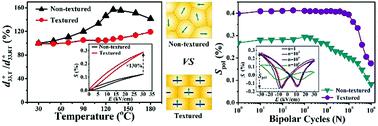当前位置:
X-MOL 学术
›
J. Mater. Chem. C
›
论文详情
Our official English website, www.x-mol.net, welcomes your
feedback! (Note: you will need to create a separate account there.)
Large, thermally stabilized and fatigue-resistant piezoelectric strain response in textured relaxor-PbTiO3 ferroelectric ceramics
Journal of Materials Chemistry C ( IF 5.7 ) Pub Date : 2020-12-23 , DOI: 10.1039/d0tc05023g Yunfei Chang 1, 2, 3, 4, 5 , Jie Wu 1, 2, 3, 4, 5 , Bin Yang 1, 2, 3, 4, 5 , Hang Xie 1, 2, 3, 4, 5 , Shuai Yang 5, 6, 7, 8, 9 , Yuan Sun 1, 2, 3, 4, 5 , Shantao Zhang 5, 10, 11, 12 , Fei Li 5, 6, 7, 8, 9 , Wenwu Cao 1, 2, 3, 4, 5
Journal of Materials Chemistry C ( IF 5.7 ) Pub Date : 2020-12-23 , DOI: 10.1039/d0tc05023g Yunfei Chang 1, 2, 3, 4, 5 , Jie Wu 1, 2, 3, 4, 5 , Bin Yang 1, 2, 3, 4, 5 , Hang Xie 1, 2, 3, 4, 5 , Shuai Yang 5, 6, 7, 8, 9 , Yuan Sun 1, 2, 3, 4, 5 , Shantao Zhang 5, 10, 11, 12 , Fei Li 5, 6, 7, 8, 9 , Wenwu Cao 1, 2, 3, 4, 5
Affiliation

|
Piezoceramics with both high strain response and excellent output stability are highly in demand for electronic actuator applications. Unfortunately, enhanced strains are generally accompanied by temperature and e-field instabilities for relaxor-PbTiO3 ferroelectrics near the curved morphotropic phase boundary (MPB). In this work, we report the simultaneous achievements of substantially enhanced piezoelectric strain (d33* ∼ 990 pm V−1), greatly improved temperature stability (strain variation below 10% over 25–150 °C) and excellent fatigue resistance (almost no strain variation at a bipolar e-field of 30 kV cm−1 up to 105 cycles) in a relaxor-PbTiO3 ferroelectric ceramic with controlled grain orientation along [001]c, based on integrating texture engineering and composite effect strategies. The temperature–insensitive strain response can be mainly attributed to the thermally stabilized εr × P (dielectric permittivity × polarization) and stable domain response over a broad temperature range, which suppressed the adverse effect (strain variation ∼60% over 25–150 °C in the non-textured counterpart) caused by the intermediate ferroelectric phase transition. Besides, the inherent anisotropy properties and enhanced domain mobility in the textured ceramics further contribute to the substantially improved fatigue endurance. This work paves the way for exploring large and stable strain response in ferroelectrics with strongly curved MPB, and can also largely broaden application areas of relaxor-PbTiO3 ceramics to high-performance, stable and robust actuators.
中文翻译:

质感弛豫-PbTiO3铁电陶瓷中的大型,热稳定且耐疲劳的压电应变响应
电子致动器应用迫切需要具有高应变响应和出色输出稳定性的压电陶瓷。不幸的是,对于弯曲的同相相界(MPB)附近的弛豫-PbTiO 3铁电体来说,应变增加通常伴随着温度和电场的不稳定性。在这项工作中,我们报告了同时提高压电应变(d 33 *〜990 pm V -1),大大提高了温度稳定性(在25–150°C时应变变化低于10%)和出色的抗疲劳性(几乎没有)的同时成就。松弛剂-PbTiO 3中在30 kV cm -1的双极电场中的应变变化(最多10 5个循环)基于集成的纹理工程和复合效果策略,可控制沿[001] c取向的铁电陶瓷。温度不敏感的应变响应可主要归因于热稳定化ε - [R × P(介电常数×极化)和在较宽温度范围内稳定的畴响应,从而抑制了由中间铁电相变引起的不利影响(在非织构对应物中,在25–150°C时应变变化约为60%)。此外,网纹陶瓷的固有各向异性和增强的畴迁移率进一步有助于显着提高疲劳强度。这项工作为探索具有强烈弯曲的MPB的铁电材料中的大而稳定的应变响应铺平了道路,并且还可以在很大程度上将Relaxer-PbTiO 3陶瓷的应用领域扩展到高性能,稳定和坚固的执行器。
更新日期:2021-01-15
中文翻译:

质感弛豫-PbTiO3铁电陶瓷中的大型,热稳定且耐疲劳的压电应变响应
电子致动器应用迫切需要具有高应变响应和出色输出稳定性的压电陶瓷。不幸的是,对于弯曲的同相相界(MPB)附近的弛豫-PbTiO 3铁电体来说,应变增加通常伴随着温度和电场的不稳定性。在这项工作中,我们报告了同时提高压电应变(d 33 *〜990 pm V -1),大大提高了温度稳定性(在25–150°C时应变变化低于10%)和出色的抗疲劳性(几乎没有)的同时成就。松弛剂-PbTiO 3中在30 kV cm -1的双极电场中的应变变化(最多10 5个循环)基于集成的纹理工程和复合效果策略,可控制沿[001] c取向的铁电陶瓷。温度不敏感的应变响应可主要归因于热稳定化ε - [R × P(介电常数×极化)和在较宽温度范围内稳定的畴响应,从而抑制了由中间铁电相变引起的不利影响(在非织构对应物中,在25–150°C时应变变化约为60%)。此外,网纹陶瓷的固有各向异性和增强的畴迁移率进一步有助于显着提高疲劳强度。这项工作为探索具有强烈弯曲的MPB的铁电材料中的大而稳定的应变响应铺平了道路,并且还可以在很大程度上将Relaxer-PbTiO 3陶瓷的应用领域扩展到高性能,稳定和坚固的执行器。











































 京公网安备 11010802027423号
京公网安备 11010802027423号